Member Login
Safety Committee
Heat Exhaustion vs Heat Stroke - Know the Difference
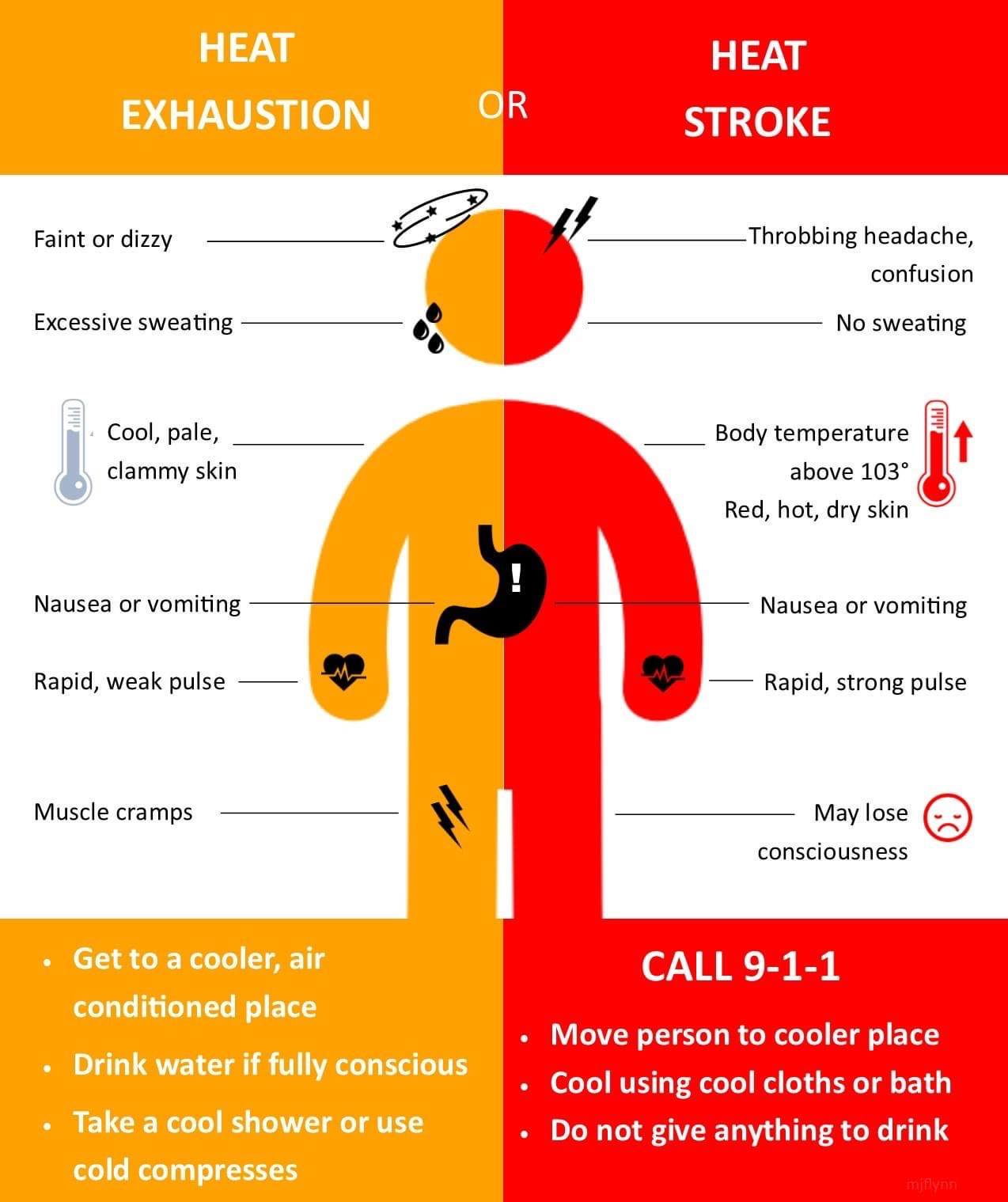
OSHA-NIOSH Heat Safety Tool App
Key considerations for using the app
Heat index (HI) values were created for shady, light wind conditions, so exposure to full sunshine can increase heat index values by up to 15°F.
The simplicity of the HI makes it a good option for many outdoor work environments (as long as there are no additional radiant heat sources, such as, fires or hot machinery). However, if you have the ability, NIOSH recommends using wet bulb globe temperature (WBGT)-based Recommended Exposure Limits (RELs) and Recommended Alert Limits (RALs) in hot environments.
Use of the HI or WBGT is important, but other factors such as strenuous physical activity also cause heat stress among workers. Employers should have a robust heat stress prevention program that ensures workers are protected.
NIOSH and OSHA are currently considering new scientific data related to the HI levels, and considering how to best incorporate the evolving science. It is important to regularly download updates to ensure you are using the latest version of the app.
Prevent Heat Illness at Work
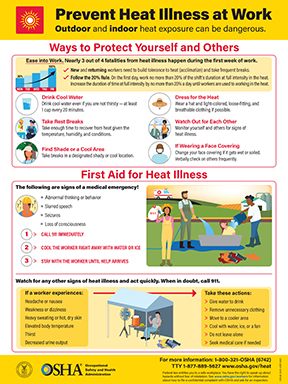 View in English
View in English
View in Spanish
Prevention » Water. Rest. Shade
Water
Employers should provide cool water for workers to drink. Proper hydration is essential to prevent heat-related illness. For those working two hours or more, also provide access to additional fluids that contain electrolytes.
For short jobs, cool potable water is sufficient. Workers should be encouraged to drink at least one cup (8 ounces) of water every 20 minutes while working in the heat not just if they are thirsty.
For longer jobs that last more than two hours, employers should provide electrolyte-containing beverages such as sports drinks. Workers lose salt and other electrolytes when they sweat. Substantial loss of electrolytes can cause muscle cramps and other dangerous health problems. Water cannot replace electrolytes; other types of beverages are needed. Water or other fluids provided by the employer should not only be cool, but should also be provided in a location that is familiar to the workers, near the work, easy to access, and in sufficient quantity for the duration of the work.
Workers should be aware that use of certain personal protective equipment (e.g., certain types of respirators and impermeable clothing) can increase the risk of heat-related illness.
Workers should not rely on feeling thirsty to prompt them to drink. They should be reminded to drink on a regular basis to maintain hydration throughout their shift and beyond.
Rest
When heat stress is high, employers should require workers to take breaks. The length and frequency of rest breaks should increase as heat stress rises. In general, workers should be taking hourly breaks whenever heat stress exceeds the limits shown in Table 2 under Determination of Whether the Work is Too Hot section on the Heat Hazard Recognition page.
Breaks should last long enough for workers to recover from the heat. How long is long enough? That depends on several factors including environmental heat (WBGT) and the worker's physical activity level, as well as the individual worker's personal risk factors. The location of the breaks also matters. If workers rest in a cooler location, they will be ready to resume work more quickly. Breaks should last longer if there is no cool location for workers to rest.
Some workers might be tempted to skip breaks. In hot conditions, skipping breaks is not safe! Employers should make sure that workers rest during all recommended break periods.
Both NIOSH and ACGIH have recommendations on appropriate lengths of work and rest cycles as a function of the workload and the WBGT (ACGIH 2017, NIOSH 2016)
Shade
Workers should be given a cool location where they can take their breaks and recover from the heat. Outdoors, this might mean a shady area, an air-conditioned vehicle, a nearby building or tent, or an area with fans and misting devices. Indoors, workers should be allowed to rest in a cool or air-conditioned area away from heat sources such as ovens and furnaces.
Heat-related Illness, from the National Safety Council
The body burns calories and produces heat to keep its temperature at 98.6 degrees Fahrenheit. In a hot environment or during vigorous physical activity, the body will rid itself of excess heat. Two effective ways it does this are sweating and dilation of blood vessels. When sweat evaporates from the skin, you begin to cool off. When blood vessels dilate, blood is brought to the skin surface to release heat.
Problems develop when the body’s cooling mechanisms do not work properly. For example, when the air temperature exceeds body temperature, the body cannot easily cool itself. If the air is humid, sweat also does not evaporate quickly. Sweat also does not evaporate from a person who works hard or exercises while wrapped in heavy clothing or protective gear. That makes heat-related illness a concern in any weather, anywhere.
Go HERE for hot tips to cool conditions and how to catch it early. (In English and Spanish)
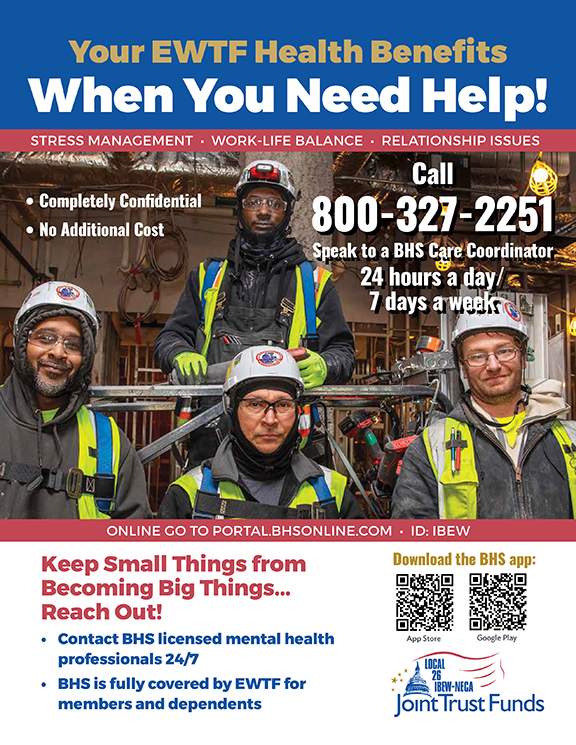 *Information Regarding Coronavirus COVID-19 Pandemic*
*Information Regarding Coronavirus COVID-19 Pandemic*
NSC Launches Free First Aid App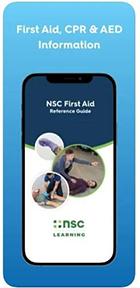
Proper Fit for Women in Construction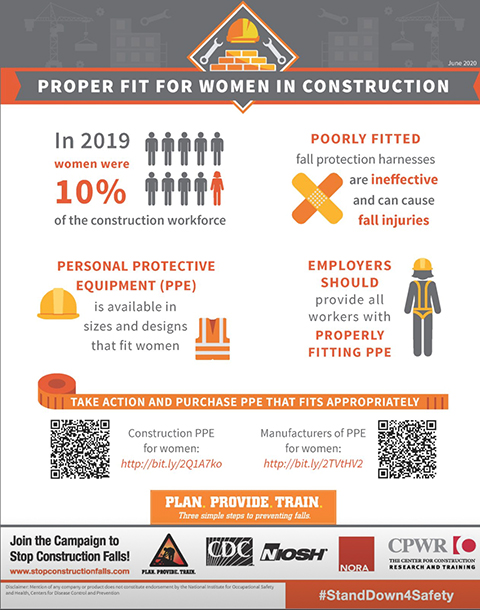
HoT work calculator tool app: Eaton's Bussmann Series FC2 Available Fault Current Calculator application is an innovative tool developed for contractors, engineers, electricians, and electrical inspectors. This tool can be used on the Bussmann website or out in the field on a mobile device for those needing a quick and simple way to determine available fault current.
With this simple tool, users can:
- Calculate available fault current on single and three-phase systems
- E-mail and print a label for marking the available fault current on service equipment (NEC® 110.24)
- Size fuses and conductors for service, feeder, and branch circuits.
What is a Safety Stand-Down?
A Safety Stand-Down is a voluntary event for employers to talk directly to employees about safety. Any workplace can hold a stand-down by taking a break to focus on "Fall Hazards" and reinforcing the importance of "Fall Prevention". Employers of companies not exposed to fall hazards, can also use this opportunity to have a conversation with employees about the other job hazards they face, protective methods, and the company's safety policies and goals. It can also be an opportunity for employees to talk to management about fall and other job hazards they see.
Did You Know?
You can register now to attend a free March 29 webinar on preventing falls through improved design. Don't forget to visit OSHA's website to learn how to participate in the 10th annual National Safety Stand-Down to Prevent Falls in Construction May 1-5.
¿Sabías?
Puede inscribirse ahora para asistir a un seminario web gratuito el 29 de marzo sobre la prevención de caídas mediante la mejora del diseño. No se olvide de visitar el sitio web de OSHA para más información sobre cómo participar en el 10º evento de la campaña nacional de prevención de caídas en la construcción del 1 al 5 de mayo.
September is National Suicide Prevention Month. Get help now!
If you're having trouble coping with work-related stress, talk with someone who can help. www.crisistextline.org
- Call the new three-digit dialing code 988 or find online chat at 988lifeline.org/chat
- Para obtener información en español, llame al 1-888-628-9454 o visite el sitio web
Suicide Prevention, 5 Things you Should Know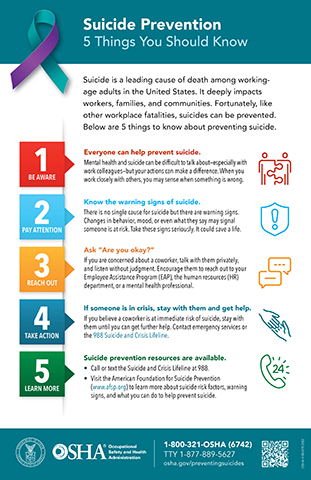
There's an App for That... OSHA has released new app regarding Heat Safety:
Take precautions against outdoor heat while at work with the OSHA-NIOSH Heat Safety Tool. Featuring real-time heat index and hourly forecasts, specific to your location, as well as occupational safety and health recommendations from OSHA and NIOSH. The OSHA-NIOSH Heat Safety Tool is a useful resource for planning outdoor work activities based on how hot it feels throughout the day. Download
Go HERE for the full article.
Safety Quote of the Day:
The most damaging phrase in the language is “We’ve always done it this way!”
— Rear Admiral Grace Murray Hopper, Presidential Medal of Freedom
OSHA•NIOSH INFO SHEET: Protecting Workers from Heat Illness
At times, workers may be required to work in hot environments for long periods. When the human body is unable to maintain a normal temperature, heat-related illnesses can occur and may result in death. This fact sheet provides information to employers on measures they should take to prevent heat-related illnesses and death.
Let's all hit the reset button and refocus on safety!
This is an excerpt from IBEW Local 1249, New York State, Lineman's Safety Training Fund, that rings true with all electrical work...
I want to challenge all of you to do a few things today and in the future:
• I want you to think about why you come to work each day and why you want to go home. That answer is why you need to make safety the most important thing.
• Identify 2 things as a crew or group that is challenging to your job and talk about how to manage that risk. I know the contractor will help get the things you need to do this.
• Identify 2 things that you individually could do better and work on it. It could be something like your driving habits or not using spotters, or how well you fill out your job briefs. Maybe it's the amount of cover up you use. Maybe it's how you treat apprentices or the quality of work you're doing . For some it's deciding to always wear you glasses and gloves and sleeves or how you treat contractor equipment.
Whatever it is, commit to being better at it.
• Reflect and share at least one near miss that you have experienced and what you learned from it...
Please go here to read the full letter.
COMPLETE YOUR OSHA TRAINING ONLINE - OSHA outreach courses! We specialize in online safety training for OSHA. Our interactive online courses include the OSHA 10-hour and OSHA 30-hour for construction and general industry. Our courses are authorized and comes with DOL card from OSHA.
National Emphasis Program (NEP) on Trenching & Excavation Safety
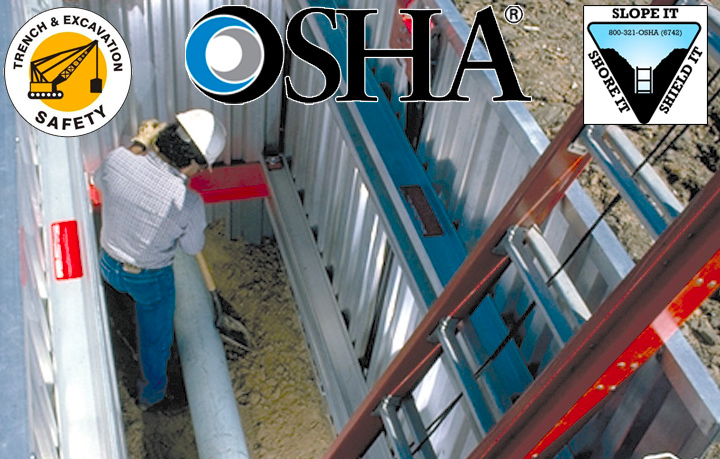
OSHA will increase focus on the hazards of open trenches and excavations. Whether they drive by, hear of, see a trench or excavation, or maybe they are performing an inspection on a neighboring site, they are required to observe, inspect, and enforce. Employers are responsible to mitigate the hazards of a potential collapse.
This NEP supersedes the 1985 Special Emphasis Program due to increased accidents and fatalities associated with trenching and excavations. The NEP reports that 130 fatalities occurred during trenching and excavation activities between 2011 and 2016, but an alarming 104 of those occurred in 2015-2016. OSHA treats every excavation and trenching operation as a collapse and cave-in risk and expects employers to do the same.
Employers should continue to follow and comply with subpart P of the construction standard. This NEP will offer an outreach program to assist employers in educating their employees, along with that there will be a three month grace period (or 100 days) for employers to train before they start issuing citations.
Train your employees before they perform the work BE PROACTIVE INSTEAD OF REACTIVE!
After the 90 day grace period Compliance officers will:
Initiate inspections upon observation of an open trench or excavation, or upon the occurrence of an incident, referral, or complaint.
Evaluate safety hazards associated with excavations and expand the scope of an inspection, if warranted.
Provide employers with information regarding existing trenching and excavation hazards.
Report all investigations, complaints, referrals, and consultations regarding trenching and excavation activities in a national reporting system
What OSHA is looking for:
Cave-ins of trench walls or adjacent structures.
Safe egress to enter and exit excavations.
Hazards from vehicular traffic.
Dangerous atmospheres or water hazards.
Heavy loads, equipment, or tools falling down into a trench.
Some examples to include in the training:
Always inspect trenches before entering.
Ensure a safe form of egress in and out of the trench.
Keep materials and equipment away from the edges.
Test for hazardous atmospheres and oxygen deficiencies.
Inspect trenches at the start of each shift and after weather events.
Always have a competent person present who is able to recognize the hazards.
Go here for the full article
Workplace Safety
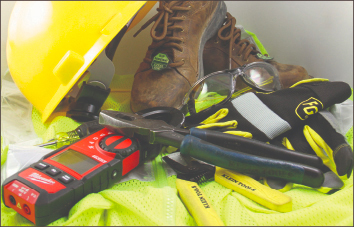
Our trade, while rewarding, can be dangerous under certain circumstances. The equipment we work around, the conditions we work in, and the vast number of people we work alongside all pose threats to our safety and health on the job if safe work practices are not a top priority. There is no place for shortcuts in our trade, there is no room for errors and, sadly, a second chance may not be possible after a bad decision is made. Quite simply, safe work practices must become habit, second nature, if we are to ensure that our members are able to return home to their families safe and sound each day. Electricity and electrical products play fundamental roles in how we do business each day. However, if not used or maintained appropriately, they can pose serious risks. Over the last ten years, more than 30,000 workers have been injured in workplace electrical accidents. While electrical hazards are not the leading cause of on-the-job injuries and accidents, they are disproportionately fatal and costly. These injuries not only disrupt the lives of the workers and their families, but also impact the productivity of employers. The good news is that most on-the-job electrocutions and electrical injuries can be prevented by following the jobsite safety rules and policies you are responsible for, your own safety, and that of your co-workers!
To that end and in accordance with the IBEW Constitution, the Local is in the process of forming a Local 26 Safety and Health Committee. The committee is currently chaired by Safety Coordinator Richard Wilkinson. The goals of the committee will be to:
• Investigate and report serious accidents and fatalities
• Cooperate with the International Office on safety and health matters
• Promote safety and health
• Cooperate with safety and health organizations as determined by the Local Union and as directed by the International Office
• Investigate and report to the International Office all serious lost-time accidents and fatalities
The success of the committee will largely depend on participation from our members. It is our goal to have members volunteer to join the committee and commit to meeting regularly. With a vast jurisdiction, we will need members representing Maryland, Virginia, and the District. The committee will work closely with our contractors to promote safety and address any accidents or safety concerns should they present themselves. In short, the committee will:
• Promote and maintain the interest of all involved in health and safety issues
• Assist any Brother or Sister who has been injured in any way possible
• Educate through awareness and training activities focused on our shared responsibility for the prevention of workplace accidents
• Help make health and safety activities an integral part of our everyday planning, operating procedures, culture, work habits, and programs
• Help our members and contractors stay informed of issues, new standards, and research as it pertains to safety and health.
• Help reduce the risk of workplace injuries
• Help our contractors stay informed about the changing federal, state, and local health and safety standards
• Create a more competitive team by making required certifications accessible to all of our members
In addition to the mandate by the IBEW Constitution to have a safety committee, such a committee is also mandated by our inside wireman’s agreement. The agreement states that a safety committee should meet not less than once a year to review OSHA safety standards and how they should be applied within the parameters and jurisdiction of our agreement. Additionally, and of paramount importance, our agreement, in Section 2.09, states that all jobsite accidents must be reported the same day to a job foreman or, in the absence of a foreman, to the employer. The foreman, or the employer as the case may be, will submit a written report to the employer’s office and the local union if requested by the business manager or president of the union. These reports will provide the kind of information that will be reviewed by the safety committee in an effort to better understand the frequency and circumstances of jobsite accidents and how best to prepare the membership to avoid such hazards.
Working towards improved safety for our members benefits our entire Local Union, protecting our members on the job so they can ply their skills in a rewarding career, and setting the IBEW apart from the rest not just in skill but in safety as well. There is no reason anyone should have to choose between their safety and their job; the two should go hand in glove.
If you would like to join the Local 26 Health and Safety Committee, report safety violations, injuries or any concerns with safety, please email the safety committee rwilkinson@ibewlocal26.org or contact Brother Rich Wilkinson at 301-543-0675. We thank you in advance for your interest in promoting and protecting the safety and health of your fellow Local 26 Brothers and Sisters. We will continue to report on our new Health and Safety Committee as information presents itself.






